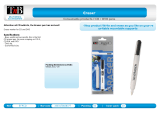
Contents Index
Contents
14
Index
14
STEP 2: SOFTWARE INSTALLATION
Save your work and close all open applications. Temporarily disable any virus protection programs.
1. Insert the Installation CD into your computer’s CD-ROM drive. If the software installer menu does not
automatically display, double-click on the I
NSTALL icon located on the CD. (When available, you can
also download and install the latest software driver from the Wacom web site for your region.)
2. Click I
NSTALL TABLET and follow the prompts to install the driver software.
3. Reactivate your virus protection program.
4. After completing the software installation, make sure you can use your pen on the Cintiq display screen
to move the screen cursor.
When you place the pen tip on the display screen, the screen cursor should immediately jump to a
corresponding position approximately beneath the pen tip. Lift the pen tip and place it on the display
screen surface in a different location. The screen cursor should again jump to the new position. This is
known as absolute positioning, and enables you to position the screen cursor without having to drag
your pen across the display screen surface. If your product model supports multi-touch, the screen
cursor will immediately jump to a position beneath your finger tip when you touch the display screen
surface.
5. Check the Read Me file for updated information. Review also the Important Product Information guide
located on the Installation CD for cautions and warnings. If you have trouble installing Cintiq, see
troubleshooting
.
6. Next, precisely align the screen cursor with the pen tip position. See calibrating the pen display
.
Notes:
User-specific preferences are supported. After logging on, each user can customize their personal
settings in the Wacom Tablet control panel. Switching to another user (either by logging on or fast
user switching methods) will automatically load the settings for that user.
If the pen display does not respond properly or you lose cursor control, the pen display preferences
may be corrupted. See managing preferences
to delete the current preference settings and return
the pen display to its factory default condition.
Driver installation automatically activates the pen input functions available within Microsoft
Windows 7, Vista, and Office 2007 or later (except for Windows 7 Starter and Home Basic, and
Windows Vista Home Basic). See pen and digital ink capabilities in Windows
.
The Cintiq 24HD touch does not support operation on Windows Vista or XP systems.
To download a new software driver (when available) from the Internet, see obtaining software
updates.
To uninstall the software driver, see uninstalling Cintiq
.




















